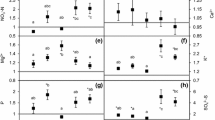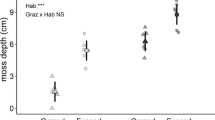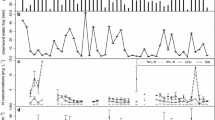Abstract
Populations of the two native Antarctic vascular plant species (Deschampsia antarctica and Colobanthus quitensis) have expanded rapidly in recent decades, yet little is known about the effects of these expansions on soil nutrient cycling. We measured the concentrations of dissolved organic carbon (DOC) and nitrogen (DON), amino acids and inorganic N in soils under these two vascular plant species, and under mosses and lichens, over a growing season at Signy Island in the maritime Antarctic. We recorded higher concentrations of nitrate, total dissolved nitrogen, DOC, DON and free amino acids in soil under D. antarctica and C. quitensis than in lichen or moss dominated soils. Each vegetation cover gave a unique profile of individual free amino acids in soil solution. Significant interactions between soil type and time were found for free amino acid concentrations and C/N ratios, indicating that vascular plants significantly change the temporal dynamics of N mineralization and immobilization. We conclude that D. antarctica and C. quitensis exert a significant influence over C and N cycling in the maritime Antarctic, and that their recent population expansion will have led to significant changes in the amount, type and rate of organic C and N cycling in soil.



Similar content being viewed by others
References
Atkinson CJ (1985) Nitrogen acquisition in four co-existing species from an upland acidic grassland. Physiol Plant 63:375–387. doi:10.1111/j.1399-3054.1985.tb02313.x
Bardgett RD, Bowman WD, Kaufmann R, Schmidt SK (2005) A temporal approach to linking aboveground and belowground ecology. Trends Ecol Evol 20:634–641. doi:10.1016/j.tree.2005.08.005
Bokhorst S, Huiskes A, Convey P, Aerts R (2007a) The effect of environmental change on vascular plant and cryptogam communities from the Falkland Islands and the Maritime Antarctic. BMC Ecol 7:15. doi:10.1186/1472-6785-7-15
Bokhorst S, Huiskes A, Convey P, Aerts R (2007b) Climate change effects on organic matter decomposition rates in ecosystems from the Maritime Antarctic and Falkland Islands. Glob Chang Biol 13:2642–2653. doi:10.1111/j.1365-2486.2007.01468.x
Chapin FS, Moilanen L, Kielland K (1993) Preferential use of organic nitrogen for growth by a non-mycorrhizal Arctic sedge. Nature 361:150–153. doi:10.1038/361150a0
Chown SL, Convey P (2007) Spatial and temporal variability across life’s hierarchies in the terrestrial Antarctic. Philos Trans R Soc B 362:2307–2331. doi:10.1098/rstb.2006.1949
Christou M, Avramides EJ, Roberts JP, Jones DL (2005) Dissolved organic nitrogen in contrasting agricultural ecosystems. Soil Biol Biochem 37:1560–1563. doi:10.1016/j.soilbio.2005.01.025
Convey P (2001) Terrestrial ecosystem responses to climate changes in the Antarctic. In: Walther GR, Burga CA, Edwards PJ (eds) Fingerprints of climate change. Kluwer/Plenum Publishers, Dordrecht/New York, pp 17–42
Davey MC, Rothery P (1992) Factors causing the limitation of growth of terrestrial algae in maritime Antarctica during late summer. Polar Biol 12:595–601. doi:10.1007/BF00236982
Downes MT (1978) An improved hydrazine reduction method for the automated determination of low nitrate levels in freshwater. Water Res 12:673–675. doi:10.1016/0043-1354(78)90177-X
Fowbert JA, Smith RIL (1994) Rapid population increases in native vascular plants in the Argentine Islands, Antarctic Peninsula. Arct Alp Res 26:290–296. doi:10.2307/1551941
Gerighausen U, Bräutigam K, Mustafa O, Peter HU (2003) Expansion of vascular plants on an Antarctic island—a consequence of climate change? In: Huiskes AHL, Gieskes WWC, Rozema J, Schorno RML, van der Vies SM, Wolff WJ (eds) Antarctic biology in a global context. Backhuys Publishers, Leiden, pp 79–83
Gornall JL, Jonsdottir IS, Woodin SJ, van der Wal R (2007) Arctic mosses govern below-ground environment and ecosystem processes. Oecologia 153:931–941. doi:10.1007/s00442-007-0785-0
Greene DM, Holtom A (1971) Studies in Colobanthus quitensis (Kunth) Bartl. and Deschampsia antarctica Desv. III. Distribution, habitats and performance in the Antarctic botanical zone. Br Antarc Surv Bull 26:1–29
Grobe CW, Ruhland CT, Day TA (1997) A new population of Colobanthus quitensis near Arthur Harbor, Antarctica: correlating recruitment with warmer summer temperatures. Arct Alp Res 29:217–221. doi:10.2307/1552049
Guglielmin M, Evans CJE, Cannone N (2008) Active layer thermal regime under different vegetation conditions in permafrost areas. A case study at Signy Island (Maritime Antarctica). Geoderma 144:73–85
Hansen J, Ruedy R, Glascoe J, Sato M (1999) GISS analysis of surface temperature change. J Geophys Res 104:30997–31022
Harrison KA, Bol R, Bardgett RD (2007) Preferences for different nitrogen forms by coexisting plant species and soil microbes. Ecology 88:989–999. doi:10.1890/06-1018
Hart JJ, DiTomaso JM, Linscott DL, Kochian LV (1992) Transport interactions between paraquat and polyamines in roots of intact maize seedlings. Plant Physiol 99:1400–1405. doi:10.1104/pp.99.4.1400
Holdgate MW, Allen SE, Chambers MJG (1967) A preliminary investigation of the soils of Signy Island, South Orkney Islands. Br Antarct Surv Bull 12:53–71
Hopkins DW, Sparrow AD, Elberling B, Gregorich EG, Novis PM, Greenfield LG, Tilston EL (2006) Carbon, nitrogen and temperature controls on microbial activity in soils from an Antarctic dry valley. Soil Biol Biochem 38:3130–3140. doi:10.1016/j.soilbio.2006.01.012
Jones DL, Kielland K (2001) Soil amino acid turnover dominates the nitrogen flux in permafrost-dominated taiga forest soils. Soil Biol Biochem 34:209–219. doi:10.1016/S0038-0717(01)00175-4
Jones DL, Edwards AC, Donachie K, Darrah PR (1994) Role of proteinaceous amino-acids released in root exudates in nutrient acquisition from the rhizosphere. Plant Soil 158:183–192. doi:10.1007/BF00009493
Jones DL, Owen AG, Farrar JF (2002) Simple method to enable the high resolution determination of free amino acids in soil solutions and soil extracts. Soil Biol Biochem 34:1893–1902. doi:10.1016/S0038-0717(02)00203-1
Jones DL, Farrar JF, Newsham KK (2004) Rapid amino acid cycling in Arctic and Antarctic soils. Water Air Soil Pollut Focus 4:169–175. doi:10.1007/s11267-004-3027-z
Jones DL, Healey JR, Willett VB, Farrar JF (2005) Dissolved organic nitrogen uptake by plants—an important N uptake pathway? Soil Biol Biochem 37:413–423. doi:10.1016/j.soilbio.2004.08.008
Kielland K (1994) Amino-acid-absorption by arctic plants—implications for plant nutrition and nitrogen cycling. Ecology 75:2373–2383. doi:10.2307/1940891
Larcher W (2003) Physiological plant ecology, 4th edn. Springer, Berlin
Lipson DA, Raab TK, Schmidt SK, Monson RK (1999) Variation in competitive abilities of plants and microbes for specific amino acids. Biol Fertil Soils 29:257–261. doi:10.1007/s003740050550
Lipson DA, Schmidt SK, Monson RK (2000) Carbon availability and temperature control the post-snowmelt decline in alpine soil microbial biomass. Soil Biol Biochem 32:441–448. doi:10.1016/S0038-0717(99)00068-1
McKane RB, Johnson LC, Shaver GR, Nadelhoffer KJ, Rastetter EB, Fry B, Giblin AE, Kielland K, Kwiatkowski BL, Laundre JA, Murray G (2002) Resource-based niches provide a basis for plant species diversity and dominance in Arctic tundra. Nature 415:68–71. doi:10.1038/415068a
Miller AE, Bowman WD (2002) Variation in 15N natural abundance and nitrogen uptake traits among co-occurring alpine species: do species partition by nitrogen form? Oecologia 130:609–616. doi:10.1007/s00442-001-0838-8
Mulvaney RL (1996) Nitrogen—inorganic forms. In: Sparks DL (ed) Methods of soil analysis. Soil Science Society of America Inc./American Society of Agronomy Inc., Madison, pp 1123–1184
Murphy J, Riley HP (1962) A modified single solution method for the determination of phosphate in natural waters. Anal Chim Acta 27:31–36. doi:10.1016/S0003-2670(00)88444-5
Nelson DL, Cox MM (2000) Lehninger principles of biochemistry. Worth, New York
Nordin A, Schmidt IK, Shaver GR (2004) Nitrogen uptake by arctic soil microbes and plants in relation to soil nitrogen supply. Ecology 85:955–962. doi:10.1890/03-0084
Owen AG, Jones DL (2001) Competition for amino acids between wheat roots and rhizosphere microorganisms and the role of amino acids in plant N acquisition. Soil Biol Biochem 33:651–657. doi:10.1016/S0038-0717(00)00209-1
Smith RIL (1994) Vascular plants as bioindicators of regional warming in Antarctica. Oecologia 99:322–328. doi:10.1007/BF00627745
Smith JL, Doran JW (1996) Measurement and use of pH and electrical conductivity. In: Doran JW, Jones AJ (eds) Methods for assessing soil quality. SSSA Spec. Publ. 49. Soil Science Society of America, Inc., Madison, pp 169–186
USEPA (2007) Test methods for evaluating solid waste (SW-846). United States Environmental Protection Agency, Washington, DC
Vaughan DG, Marshall GJ, Connolley WM, King JC, Mulvaney R (2001) Devil in the detail. Science 293:1777–1779. doi:10.1126/science.1065116
Walther GR, Post E, Convey P, Menzel A, Parmesan C, Beebee TJC, Fromentin JM, Hoegh-Guldberg O, Bairlein F (2002) Ecological responses to recent climate change. Nature 416:389–395. doi:10.1038/416389a
Weigelt A, Bol R, Bardgett RD (2005) Preferential uptake of soil nitrogen forms by grassland plant species. Oecologia 142:627–635. doi:10.1007/s00442-004-1765-2
Acknowledgments
This research was funded by the Natural Environment Research Council’s Antarctic Funding Initiative scheme (NER/G/S/2003/00008). Support from the crew of RRS Ernest Shackleton and the BAS Logistics Section is gratefully acknowledged. Peter Rothery of CEH Monks Wood gave valuable statistical advice. Professor Sieglinde Ott and an anonymous referee provided helpful comments.
Author information
Authors and Affiliations
Corresponding author
Rights and permissions
About this article
Cite this article
Roberts, P., Newsham, K.K., Bardgett, R.D. et al. Vegetation cover regulates the quantity, quality and temporal dynamics of dissolved organic carbon and nitrogen in Antarctic soils. Polar Biol 32, 999–1008 (2009). https://doi.org/10.1007/s00300-009-0599-0
Received:
Revised:
Accepted:
Published:
Issue Date:
DOI: https://doi.org/10.1007/s00300-009-0599-0




